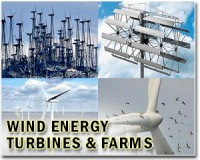 |
Champaign IL (SPX) Oct 13, 2010 Wind power is likely to play a large role in the future of sustainable, clean energy, but wide-scale adoption has remained elusive. Now, researchers have found wind farms' effects on local temperatures and proposed strategies for mediating those effects, increasing the potential to expand wind farms to a utility-scale energy resource. Led by University of Illinois professor of atmospheric sciences Somnath Baidya Roy, the research team will publish its findings in the Proceedings of the National Academy of Sciences. The paper will appear in the journal's Online Early Edition this week. Roy first proposed a model describing the local climate impact of wind farms in a 2004 paper. But that and similar subsequent studies have been based solely on models because of a lack of available data. In fact, no field data on temperature were publicly available for researchers to use, until Roy met Neil Kelley at a 2009 conference. Kelley, a principal scientist at the National Wind Technology Center, part of the National Renewable Energy Laboratory, had collected temperature data at a wind farm in San Gorgonio, Calif., for more than seven weeks in 1989. Analysis of Kelley's data corroborated Roy's modeling studies and provided the first observation-based evidence of wind farms' effects on local temperature. The study found that the area immediately surrounding turbines was slightly cooler during the day and slightly warmer at night than the rest of the region. As a small-scale modeling expert, Roy was most interested in determining the processes that drive the daytime cooling and nocturnal warming effects. He identified an enhanced vertical mixing of warm and cool air in the atmosphere in the wake of the turbine rotors. As the rotors turn, they generate turbulence, like the wake of a speedboat motor. Upper-level air is pulled down toward the surface while surface-level air is pushed up, causing warmer and cooler air to mix. The question for any given wind-farm site then becomes, will warming or cooling be the predominant effect? "It depends on the location," Roy said. "For example, in the Great Plains region, the winds are typically stronger at night, so the nocturnal effect may dominate. In a region where daytime winds are stronger - for example a sea breeze - then the cooling effect will dominate. It's a very location-specific thing." Many wind farms, especially in the Midwestern United States, are located on farmland. According to Roy, the nocturnal warming effect could offer farmland some measure of frost protection and may even slightly extend the growing season. Understanding the temperature effects and the processes that cause them also allows researchers to develop strategies to mitigate wind farms' impact on local climate. The group identified two possible solutions. First, engineers could develop low-turbulence rotors. Less turbulence would not only lead to less vertical mixing and therefore less climate impact, but also would be more efficient for energy generation. However, research and development for such a device could be a costly, labor-intensive process. The second mediation strategy is locational. Turbulence from the rotors has much less consequence in an already turbulent atmosphere. The researchers used global data to identify regions where temperature effects of large wind farms are likely to be low because of natural mixing in the atmosphere, providing ideal sites. "These regions include the Midwest and the Great Plains as well as large parts of Europe and China," Roy said. "This was a very coarse-scale study, but it would be easy to do a local-scale study to compare possible locations." Next, Roy's group will generate models looking at both temperature and moisture transport using data from and simulations of commercial rotors and turbines. They also plan to study the extent of the thermodynamic effects, both in terms of local magnitude and of how far downwind the effects spread. "The time is right for this kind of research so that, before we take a leap, we make sure it can be done right," Roy said. "We want to identify the best way to sustain an explosive growth in wind energy over the long term. Wind energy is likely to be a part of the solution to the atmospheric carbon dioxide and the global warming problem. By indentifying impacts and potential mitigation strategies, this study will contribute to the long-term sustainability of wind power."
Share This Article With Planet Earth
Related Links University of Illinois Wind Energy News at Wind Daily
 Google in major bid for Eastern US wind power
Google in major bid for Eastern US wind powerWashington (AFP) Oct 12, 2010 Investors led by technology giant Google on Tuesday announced a five billion-dollar project to power the US East Coast with wind from the Atlantic Ocean, in an ambitious bid to spur alternative energy. The project would set up offshore wind turbines and a new transmission grid stretching 350 miles (565 kilometers) from New Jersey to Virginia, the most densely populated part of the United Sta ... read more |
|
| The content herein, unless otherwise known to be public domain, are Copyright 1995-2010 - SpaceDaily. AFP and UPI Wire Stories are copyright Agence France-Presse and United Press International. ESA Portal Reports are copyright European Space Agency. All NASA sourced material is public domain. Additional copyrights may apply in whole or part to other bona fide parties. Advertising does not imply endorsement,agreement or approval of any opinions, statements or information provided by SpaceDaily on any Web page published or hosted by SpaceDaily. Privacy Statement |